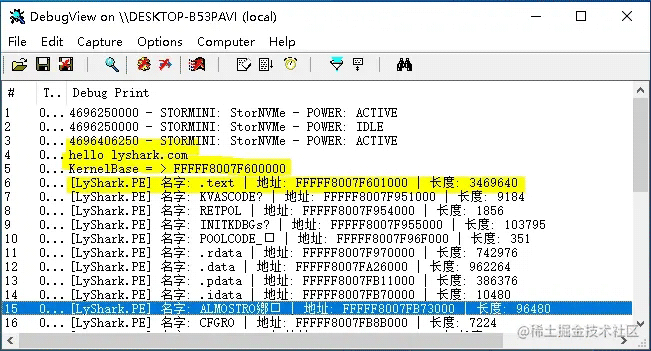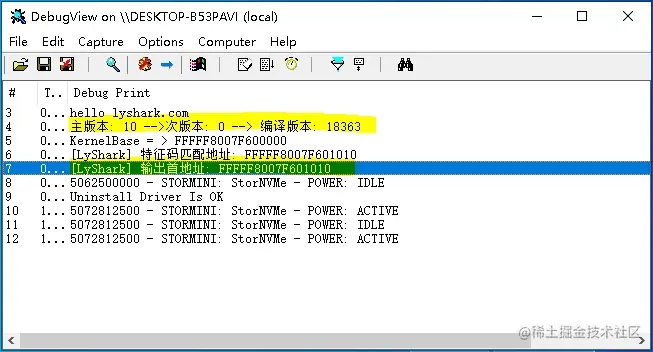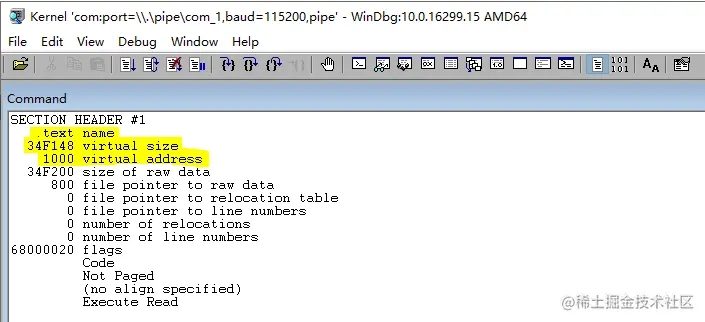为网友们分享了相关的编程文章,网友陆曼青根据主题投稿了本篇教程内容,涉及到C语言、内核特征码扫描PE、C语言、PE扫描、C语言 内核特征码扫描PE相关内容,已被593网友关注,相关难点技巧可以阅读下方的电子资料。
C语言 内核特征码扫描PE
正文
在笔者上一篇文章《驱动开发:内核特征码搜索函数封装》中为了定位特征的方便我们封装实现了一个可以传入数组实现的SearchSpecialCode定位函数,该定位函数其实还不能算的上简单,本章LyShark将对特征码定位进行简化,让定位变得更简单,并运用定位代码实现扫描内核PE的.text代码段,并从代码段中得到某个特征所在内存位置。
老样子为了后续教程能够继续,先来定义一个lyshark.h头文件,该头文件中包含了我们本篇文章所必须要使用到的结构体定义,这些定义的函数如果不懂请去看LyShark以前的文章,这里就不罗嗦了。
#include#include typedef struct _KLDR_DATA_TABLE_ENTRY { LIST_ENTRY64 InLoadOrderLinks; ULONG64 __Undefined1; ULONG64 __Undefined2; ULONG64 __Undefined3; ULONG64 NonPagedDebugInfo; ULONG64 DllBase; ULONG64 EntryPoint; ULONG SizeOfImage; UNICODE_STRING FullDllName; UNICODE_STRING BaseDllName; ULONG Flags; USHORT LoadCount; USHORT __Undefined5; ULONG64 __Undefined6; ULONG CheckSum; ULONG __padding1; ULONG TimeDateStamp; ULONG __padding2; }KLDR_DATA_TABLE_ENTRY, *PKLDR_DATA_TABLE_ENTRY; typedef struct _RTL_PROCESS_MODULE_INFORMATION { HANDLE Section; PVOID MappedBase; PVOID ImageBase; ULONG ImageSize; ULONG Flags; USHORT LoadOrderIndex; USHORT InitOrderIndex; USHORT LoadCount; USHORT OffsetToFileName; UCHAR FullPathName[256]; } RTL_PROCESS_MODULE_INFORMATION, *PRTL_PROCESS_MODULE_INFORMATION; typedef struct _RTL_PROCESS_MODULES { ULONG NumberOfModules; RTL_PROCESS_MODULE_INFORMATION Modules[1]; } RTL_PROCESS_MODULES, *PRTL_PROCESS_MODULES; typedef enum _SYSTEM_INFORMATION_CLASS { SystemBasicInformation = 0x0, SystemProcessorInformation = 0x1, SystemPerformanceInformation = 0x2, SystemTimeOfDayInformation = 0x3, SystemPathInformation = 0x4, SystemProcessInformation = 0x5, SystemCallCountInformation = 0x6, SystemDeviceInformation = 0x7, SystemProcessorPerformanceInformation = 0x8, SystemFlagsInformation = 0x9, SystemCallTimeInformation = 0xa, SystemModuleInformation = 0xb, SystemLocksInformation = 0xc, SystemStackTraceInformation = 0xd, SystemPagedPoolInformation = 0xe, SystemNonPagedPoolInformation = 0xf, SystemHandleInformation = 0x10, SystemObjectInformation = 0x11, SystemPageFileInformation = 0x12, SystemVdmInstemulInformation = 0x13, SystemVdmBopInformation = 0x14, SystemFileCacheInformation = 0x15, SystemPoolTagInformation = 0x16, SystemInterruptInformation = 0x17, SystemDpcBehaviorInformation = 0x18, SystemFullMemoryInformation = 0x19, SystemLoadGdiDriverInformation = 0x1a, SystemUnloadGdiDriverInformation = 0x1b, SystemTimeAdjustmentInformation = 0x1c, SystemSummaryMemoryInformation = 0x1d, SystemMirrorMemoryInformation = 0x1e, SystemPerformanceTraceInformation = 0x1f, SystemObsolete0 = 0x20, SystemExceptionInformation = 0x21, SystemCrashDumpStateInformation = 0x22, SystemKernelDebuggerInformation = 0x23, SystemContextSwitchInformation = 0x24, SystemRegistryQuotaInformation = 0x25, SystemExtendServiceTableInformation = 0x26, SystemPrioritySeperation = 0x27, SystemVerifierAddDriverInformation = 0x28, SystemVerifierRemoveDriverInformation = 0x29, SystemProcessorIdleInformation = 0x2a, SystemLegacyDriverInformation = 0x2b, SystemCurrentTimeZoneInformation = 0x2c, SystemLookasideInformation = 0x2d, SystemTimeSlipNotification = 0x2e, SystemSessionCreate = 0x2f, SystemSessionDetach = 0x30, SystemSessionInformation = 0x31, SystemRangeStartInformation = 0x32, SystemVerifierInformation = 0x33, SystemVerifierThunkExtend = 0x34, SystemSessionProcessInformation = 0x35, SystemLoadGdiDriverInSystemSpace = 0x36, SystemNumaProcessorMap = 0x37, SystemPrefetcherInformation = 0x38, SystemExtendedProcessInformation = 0x39, SystemRecommendedSharedDataAlignment = 0x3a, SystemComPlusPackage = 0x3b, SystemNumaAvailableMemory = 0x3c, SystemProcessorPowerInformation = 0x3d, SystemEmulationBasicInformation = 0x3e, SystemEmulationProcessorInformation = 0x3f, SystemExtendedHandleInformation = 0x40, SystemLostDelayedWriteInformation = 0x41, SystemBigPoolInformation = 0x42, SystemSessionPoolTagInformation = 0x43, SystemSessionMappedViewInformation = 0x44, SystemHotpatchInformation = 0x45, SystemObjectSecurityMode = 0x46, SystemWatchdogTimerHandler = 0x47, SystemWatchdogTimerInformation = 0x48, SystemLogicalProcessorInformation = 0x49, SystemWow64SharedInformationObsolete = 0x4a, SystemRegisterFirmwareTableInformationHandler = 0x4b, SystemFirmwareTableInformation = 0x4c, SystemModuleInformationEx = 0x4d, SystemVerifierTriageInformation = 0x4e, SystemSuperfetchInformation = 0x4f, SystemMemoryListInformation = 0x50, SystemFileCacheInformationEx = 0x51, SystemThreadPriorityClientIdInformation = 0x52, SystemProcessorIdleCycleTimeInformation = 0x53, SystemVerifierCancellationInformation = 0x54, SystemProcessorPowerInformationEx = 0x55, SystemRefTraceInformation = 0x56, SystemSpecialPoolInformation = 0x57, SystemProcessIdInformation = 0x58, SystemErrorPortInformation = 0x59, SystemBootEnvironmentInformation = 0x5a, SystemHypervisorInformation = 0x5b, SystemVerifierInformationEx = 0x5c, SystemTimeZoneInformation = 0x5d, SystemImageFileExecutionOptionsInformation = 0x5e, SystemCoverageInformation = 0x5f, SystemPrefetchPatchInformation = 0x60, SystemVerifierFaultsInformation = 0x61, SystemSystemPartitionInformation = 0x62, SystemSystemDiskInformation = 0x63, SystemProcessorPerformanceDistribution = 0x64, SystemNumaProximityNodeInformation = 0x65, SystemDynamicTimeZoneInformation = 0x66, SystemCodeIntegrityInformation = 0x67, SystemProcessorMicrocodeUpdateInformation = 0x68, SystemProcessorBrandString = 0x69, SystemVirtualAddressInformation = 0x6a, SystemLogicalProcessorAndGroupInformation = 0x6b, SystemProcessorCycleTimeInformation = 0x6c, SystemStoreInformation = 0x6d, SystemRegistryAppendString = 0x6e, SystemAitSamplingValue = 0x6f, SystemVhdBootInformation = 0x70, SystemCpuQuotaInformation = 0x71, SystemNativeBasicInformation = 0x72, SystemErrorPortTimeouts = 0x73, SystemLowPriorityIoInformation = 0x74, SystemBootEntropyInformation = 0x75, SystemVerifierCountersInformation = 0x76, SystemPagedPoolInformationEx = 0x77, SystemSystemPtesInformationEx = 0x78, SystemNodeDistanceInformation = 0x79, SystemAcpiAuditInformation = 0x7a, SystemBasicPerformanceInformation = 0x7b, SystemQueryPerformanceCounterInformation = 0x7c, SystemSessionBigPoolInformation = 0x7d, SystemBootGraphicsInformation = 0x7e, SystemScrubPhysicalMemoryInformation = 0x7f, SystemBadPageInformation = 0x80, SystemProcessorProfileControlArea = 0x81, SystemCombinePhysicalMemoryInformation = 0x82, SystemEntropyInterruptTimingInformation = 0x83, SystemConsoleInformation = 0x84, SystemPlatformBinaryInformation = 0x85, SystemThrottleNotificationInformation = 0x86, SystemHypervisorProcessorCountInformation = 0x87, SystemDeviceDataInformation = 0x88, SystemDeviceDataEnumerationInformation = 0x89, SystemMemoryTopologyInformation = 0x8a, SystemMemoryChannelInformation = 0x8b, SystemBootLogoInformation = 0x8c, SystemProcessorPerformanceInformationEx = 0x8d, SystemSpare0 = 0x8e, SystemSecureBootPolicyInformation = 0x8f, SystemPageFileInformationEx = 0x90, SystemSecureBootInformation = 0x91, SystemEntropyInterruptTimingRawInformation = 0x92, SystemPortableWorkspaceEfiLauncherInformation = 0x93, SystemFullProcessInformation = 0x94, SystemKernelDebuggerInformationEx = 0x95, SystemBootMetadataInformation = 0x96, SystemSoftRebootInformation = 0x97, SystemElamCertificateInformation = 0x98, SystemOfflineDumpConfigInformation = 0x99, SystemProcessorFeaturesInformation = 0x9a, SystemRegistryReconciliationInformation = 0x9b, MaxSystemInfoClass = 0x9c, } SYSTEM_INFORMATION_CLASS; // 声明函数 // By: Lyshark.com NTSYSAPI PIMAGE_NT_HEADERS NTAPI RtlImageNtHeader(_In_ PVOID Base); NTSTATUS NTAPI ZwQuerySystemInformation(SYSTEM_INFORMATION_CLASS SystemInformationClass, PVOID SystemInformation, ULONG SystemInformationLength, PULONG ReturnLength); typedef VOID(__cdecl *PMiProcessLoaderEntry)(PKLDR_DATA_TABLE_ENTRY section, IN LOGICAL Insert); typedef NTSTATUS(*NTQUERYSYSTEMINFORMATION)(IN ULONG SystemInformationClass, OUT PVOID SystemInformation, IN ULONG_PTR SystemInformationLength, OUT PULONG_PTR ReturnLength OPTIONAL);
特征码字符串解析与扫描实现
我们继续,首先实现特征码字符串的解析与扫描实现此处UtilLySharkSearchPattern函数就是LyShark封装过的,这里依次介绍一下参数传递的含义。
- pattern 用于传入一段字符串特征值
(以\x开头) - len 代表输入特征码长度
(除去\x后的长度) - base 代表扫描内存的基地址
- size 代表需要向下扫描的长度
- ppFound 代表扫描到首地址以后返回的内存地址
UtilLySharkSearchPattern如何定位特征
这段代码该如何使用,如下我们以定位IoInitializeTimer为例,演示UtilLySharkSearchPattern如何定位特征的,如下代码pattern变量中就是我们需要定位的特征值,pattern_size则是需要定位的特征码长度,在address地址位置向下扫描128字节,找到则返回到find_address变量内。
// 署名权
// right to sign one's name on a piece of work
// PowerBy: LyShark
// Email: me@lyshark.com
#include "lyshark.h"
PVOID GetIoInitializeTimerAddress()
{
PVOID VariableAddress = 0;
UNICODE_STRING uioiTime = { 0 };
RtlInitUnicodeString(&uioiTime, L"IoInitializeTimer");
VariableAddress = (PVOID)MmGetSystemRoutineAddress(&uioiTime);
if (VariableAddress != 0)
{
return VariableAddress;
}
return 0;
}
// 对指定内存执行特征码扫描
NTSTATUS UtilLySharkSearchPattern(IN PUCHAR pattern, IN ULONG_PTR len, IN const VOID* base, IN ULONG_PTR size, OUT PVOID* ppFound)
{
// 计算匹配长度
// LyShark.com 特征码扫描
NT_ASSERT(ppFound != 0 && pattern != 0 && base != 0);
if (ppFound == 0 || pattern == 0 || base == 0)
{
return STATUS_INVALID_PARAMETER;
}
__try
{
for (ULONG_PTR i = 0; i < size - len; i++)
{
BOOLEAN found = TRUE;
for (ULONG_PTR j = 0; j < len; j++)
{
if (pattern[j] != ((PUCHAR)base)[i + j])
{
found = FALSE;
break;
}
}
if (found != FALSE)
{
*ppFound = (PUCHAR)base + i;
DbgPrint("[LyShark.com] 特征码匹配地址: %p \n", (PUCHAR)base + i);
return STATUS_SUCCESS;
}
}
}
__except (EXCEPTION_EXECUTE_HANDLER)
{
return STATUS_UNHANDLED_EXCEPTION;
}
return STATUS_NOT_FOUND;
}
VOID UnDriver(PDRIVER_OBJECT driver)
{
DbgPrint(("Uninstall Driver Is OK \n"));
}
NTSTATUS DriverEntry(IN PDRIVER_OBJECT Driver, PUNICODE_STRING RegistryPath)
{
DbgPrint(("hello lyshark.com \n"));
// 返回匹配长度5
CHAR pattern[] = "\x48\x89\x6c\x24\x10";
PVOID *find_address = NULL;
int pattern_size = sizeof(pattern) - 1;
DbgPrint("匹配长度: %d \n", pattern_size);
// 得到基地址
PVOID address = GetIoInitializeTimerAddress();
// 扫描特征
NTSTATUS nt = UtilLySharkSearchPattern((PUCHAR)pattern, pattern_size, address, 128, &find_address);
DbgPrint("[LyShark 返回地址 => ] 0x%p \n", (ULONG64)find_address);
Driver->DriverUnload = UnDriver;
return STATUS_SUCCESS;
}
运行驱动程序完成特征定位,并对比定位效果。

RtlImageNtHeader对其PE头部解析
如上述所示定位函数我们已经封装好了,相信你也能感受到这种方式要比使用数组更方便,为了能定位到内核PE结构我们需要使用RtlImageNtHeader来解析,这个内核函数专门用来得到内核程序的PE头部结构的,在下方案例中首先我们使用封装过的LySharkToolsUtilKernelBase函数拿到内核基址,如果你不懂函数实现细节请阅读《驱动开发:内核取ntoskrnl模块基地址》这篇文章,拿到基址以后可以直接使用RtlImageNtHeader对其PE头部进行解析,如下所示。
// 署名权
// right to sign one's name on a piece of work
// PowerBy: LyShark
// Email: me@lyshark.com
#include "lyshark.h"
// 定义全局变量
static PVOID g_KernelBase = 0;
static ULONG g_KernelSize = 0;
// 得到KernelBase基地址
// lyshark.com
PVOID LySharkToolsUtilKernelBase(OUT PULONG pSize)
{
NTSTATUS status = STATUS_SUCCESS;
ULONG bytes = 0;
PRTL_PROCESS_MODULES pMods = 0;
PVOID checkPtr = 0;
UNICODE_STRING routineName;
if (g_KernelBase != 0)
{
if (pSize)
{
*pSize = g_KernelSize;
}
return g_KernelBase;
}
RtlInitUnicodeString(&routineName, L"NtOpenFile");
checkPtr = MmGetSystemRoutineAddress(&routineName);
if (checkPtr == 0)
return 0;
__try
{
status = ZwQuerySystemInformation(SystemModuleInformation, 0, bytes, &bytes);
if (bytes == 0)
{
return 0;
}
pMods = (PRTL_PROCESS_MODULES)ExAllocatePoolWithTag(NonPagedPoolNx, bytes, L"LyShark");
RtlZeroMemory(pMods, bytes);
status = ZwQuerySystemInformation(SystemModuleInformation, pMods, bytes, &bytes);
if (NT_SUCCESS(status))
{
PRTL_PROCESS_MODULE_INFORMATION pMod = pMods->Modules;
for (ULONG i = 0; i < pMods->NumberOfModules; i++)
{
if (checkPtr >= pMod[i].ImageBase && checkPtr < (PVOID)((PUCHAR)pMod[i].ImageBase + pMod[i].ImageSize))
{
g_KernelBase = pMod[i].ImageBase;
g_KernelSize = pMod[i].ImageSize;
if (pSize)
{
*pSize = g_KernelSize;
}
break;
}
}
}
}
__except (EXCEPTION_EXECUTE_HANDLER)
{
return 0;
}
if (pMods)
{
ExFreePoolWithTag(pMods, L"LyShark");
}
DbgPrint("KernelBase = > %p \n", g_KernelBase);
return g_KernelBase;
}
VOID UnDriver(PDRIVER_OBJECT driver)
{
DbgPrint(("Uninstall Driver Is OK \n"));
}
NTSTATUS DriverEntry(IN PDRIVER_OBJECT Driver, PUNICODE_STRING RegistryPath)
{
DbgPrint(("hello lyshark.com \n"));
// 获取内核第一个模块的基地址
PVOID base = LySharkToolsUtilKernelBase(0);
if (!base)
return STATUS_NOT_FOUND;
// 得到NT头部PE32+结构
// lyshark.com
PIMAGE_NT_HEADERS64 pHdr = RtlImageNtHeader(base);
if (!pHdr)
return STATUS_INVALID_IMAGE_FORMAT;
// 首先寻找代码段
PIMAGE_SECTION_HEADER pFirstSection = (PIMAGE_SECTION_HEADER)(pHdr + 1);
for (PIMAGE_SECTION_HEADER pSection = pFirstSection; pSection < pFirstSection + pHdr->FileHeader.NumberOfSections; pSection++)
{
ANSI_STRING LySharkSection, LySharkName;
RtlInitAnsiString(&LySharkSection, ".text");
RtlInitAnsiString(&LySharkName, (PCCHAR)pSection->Name);
DbgPrint("[LyShark.PE] 名字: %Z | 地址: %p | 长度: %d \n", LySharkName, (PUCHAR)base + pSection->VirtualAddress, pSection->Misc.VirtualSize);
}
Driver->DriverUnload = UnDriver;
return STATUS_SUCCESS;
}
运行这段驱动程序,你会得到当前内核的所有PE节信息,枚举效果如下所示。

既然能够得到PE头部数据了,那么我们只需要扫描这段空间并得到匹配到的数据即可,其实很容易实现,如下代码所示。
// 署名权
// right to sign one's name on a piece of work
// PowerBy: LyShark
// Email: me@lyshark.com
#include "lyshark.h"
// 定义全局变量
static PVOID g_KernelBase = 0;
static ULONG g_KernelSize = 0;
// 得到KernelBase基地址
// lyshark.com
PVOID LySharkToolsUtilKernelBase(OUT PULONG pSize)
{
NTSTATUS status = STATUS_SUCCESS;
ULONG bytes = 0;
PRTL_PROCESS_MODULES pMods = 0;
PVOID checkPtr = 0;
UNICODE_STRING routineName;
if (g_KernelBase != 0)
{
if (pSize)
{
*pSize = g_KernelSize;
}
return g_KernelBase;
}
RtlInitUnicodeString(&routineName, L"NtOpenFile");
checkPtr = MmGetSystemRoutineAddress(&routineName);
if (checkPtr == 0)
return 0;
__try
{
status = ZwQuerySystemInformation(SystemModuleInformation, 0, bytes, &bytes);
if (bytes == 0)
{
return 0;
}
pMods = (PRTL_PROCESS_MODULES)ExAllocatePoolWithTag(NonPagedPoolNx, bytes, L"LyShark");
RtlZeroMemory(pMods, bytes);
status = ZwQuerySystemInformation(SystemModuleInformation, pMods, bytes, &bytes);
if (NT_SUCCESS(status))
{
PRTL_PROCESS_MODULE_INFORMATION pMod = pMods->Modules;
for (ULONG i = 0; i < pMods->NumberOfModules; i++)
{
if (checkPtr >= pMod[i].ImageBase && checkPtr < (PVOID)((PUCHAR)pMod[i].ImageBase + pMod[i].ImageSize))
{
g_KernelBase = pMod[i].ImageBase;
g_KernelSize = pMod[i].ImageSize;
if (pSize)
{
*pSize = g_KernelSize;
}
break;
}
}
}
}
__except (EXCEPTION_EXECUTE_HANDLER)
{
return 0;
}
if (pMods)
{
ExFreePoolWithTag(pMods, L"LyShark");
}
DbgPrint("KernelBase = > %p \n", g_KernelBase);
return g_KernelBase;
}
// 对指定内存执行特征码扫描
NTSTATUS UtilLySharkSearchPattern(IN PUCHAR pattern, IN UCHAR wildcard, IN ULONG_PTR len, IN const VOID* base, IN ULONG_PTR size, OUT PVOID* ppFound)
{
NT_ASSERT(ppFound != 0 && pattern != 0 && base != 0);
if (ppFound == 0 || pattern == 0 || base == 0)
{
return STATUS_INVALID_PARAMETER;
}
__try
{
for (ULONG_PTR i = 0; i < size - len; i++)
{
BOOLEAN found = TRUE;
for (ULONG_PTR j = 0; j < len; j++)
{
if (pattern[j] != wildcard && pattern[j] != ((PUCHAR)base)[i + j])
{
found = FALSE;
break;
}
}
if (found != FALSE)
{
*ppFound = (PUCHAR)base + i;
DbgPrint("[LyShark] 特征码匹配地址: %p \n", (PUCHAR)base + i);
return STATUS_SUCCESS;
}
}
}
__except (EXCEPTION_EXECUTE_HANDLER)
{
return STATUS_UNHANDLED_EXCEPTION;
}
return STATUS_NOT_FOUND;
}
// 扫描代码段中的指令片段
NTSTATUS ByLySharkComUtilScanSection(IN PCCHAR section, IN PUCHAR pattern, IN UCHAR wildcard, IN ULONG_PTR len, OUT PVOID* ppFound)
{
NT_ASSERT(ppFound != 0);
if (ppFound == 0)
return STATUS_INVALID_PARAMETER;
// 获取内核第一个模块的基地址
PVOID base = LySharkToolsUtilKernelBase(0);
if (!base)
return STATUS_NOT_FOUND;
// 得到NT头部PE32+结构
PIMAGE_NT_HEADERS64 pHdr = RtlImageNtHeader(base);
if (!pHdr)
return STATUS_INVALID_IMAGE_FORMAT;
// 首先寻找代码段
PIMAGE_SECTION_HEADER pFirstSection = (PIMAGE_SECTION_HEADER)(pHdr + 1);
for (PIMAGE_SECTION_HEADER pSection = pFirstSection; pSection < pFirstSection + pHdr->FileHeader.NumberOfSections; pSection++)
{
ANSI_STRING LySharkSection, LySharkText;
RtlInitAnsiString(&LySharkSection, section);
RtlInitAnsiString(&LySharkText, (PCCHAR)pSection->Name);
// 判断是不是我们要找的.text节
if (RtlCompareString(&LySharkSection, &LySharkText, TRUE) == 0)
{
// 如果是则开始匹配特征码
return UtilLySharkSearchPattern(pattern, wildcard, len, (PUCHAR)base + pSection->VirtualAddress, pSection->Misc.VirtualSize, ppFound);
}
}
return STATUS_NOT_FOUND;
}
VOID UnDriver(PDRIVER_OBJECT driver)
{
DbgPrint(("Uninstall Driver Is OK \n"));
}
NTSTATUS DriverEntry(IN PDRIVER_OBJECT Driver, PUNICODE_STRING RegistryPath)
{
DbgPrint("hello lyshark.com \n");
PMiProcessLoaderEntry m_MiProcessLoaderEntry = NULL;
RTL_OSVERSIONINFOW Version = { 0 };
Version.dwOSVersionInfoSize = sizeof(Version);
RtlGetVersion(&Version);
//获取内核版本号
DbgPrint("主版本: %d -->次版本: %d --> 编译版本: %d", Version.dwMajorVersion, Version.dwMinorVersion, Version.dwBuildNumber);
if (Version.dwMajorVersion == 10)
{
// 如果是 win10 18363 则匹配特征
if (Version.dwBuildNumber == 18363)
{
CHAR pattern[] = "\x48\x89\x5c\x24\x08";
int pattern_size = sizeof(pattern) - 1;
ByLySharkComUtilScanSection(".text", (PUCHAR)pattern, 0xCC, pattern_size, (PVOID *)&m_MiProcessLoaderEntry);
DbgPrint("[LyShark] 输出首地址: %p", m_MiProcessLoaderEntry);
}
}
Driver->DriverUnload = UnDriver;
return STATUS_SUCCESS;
}
代码中首先判断系统主版本windows 10 18363如果是则执行匹配,只匹配.text也就是代码段中的数据,当遇到0xcc时则取消继续,否则继续执行枚举,程序输出效果如下所示。

在WinDBG中输入命令!dh 0xfffff8007f600000解析出内核PE头数据,可以看到如下所示,对比无误。

以上就是C语言驱动开发内核特征码扫描PE代码段的详细内容,更多关于C语言 内核特征码扫描PE的资料请关注码农之家其它相关文章!


















